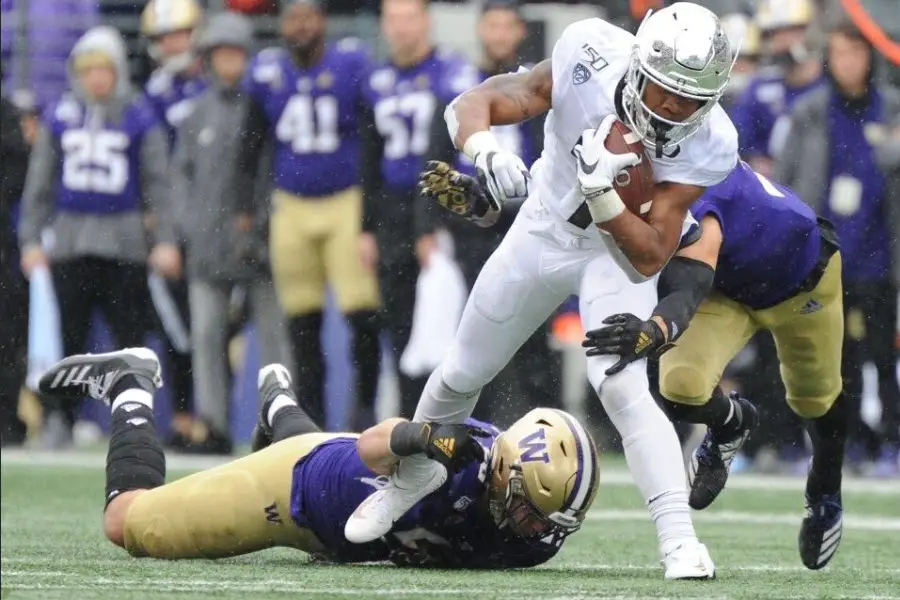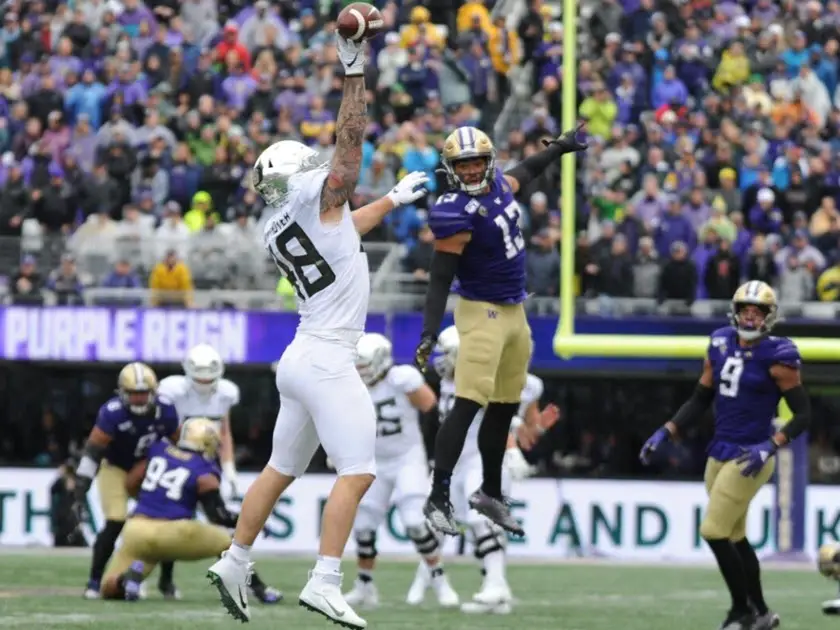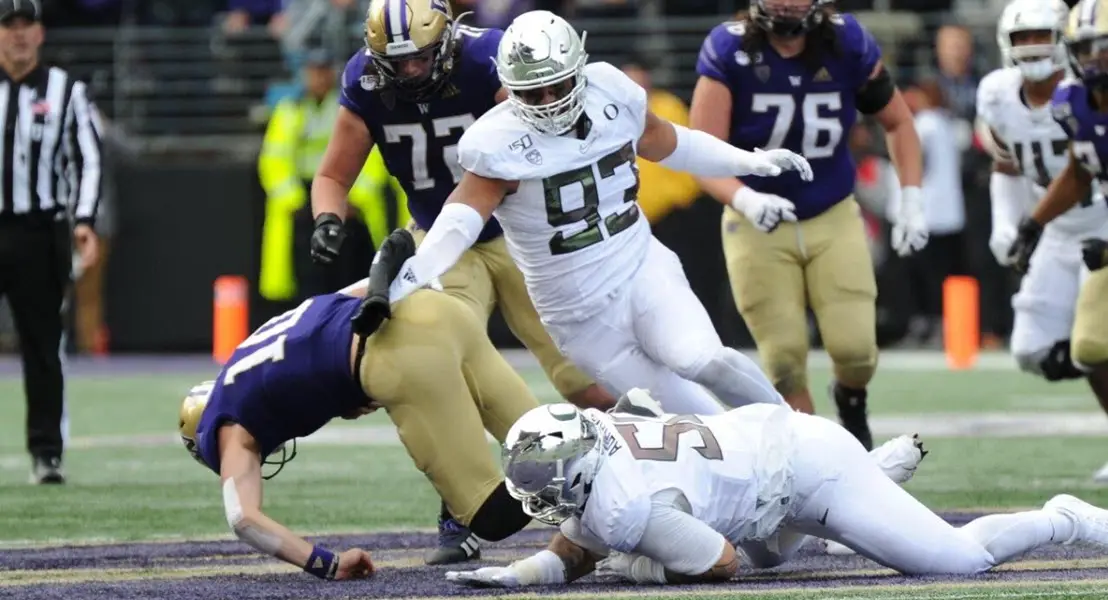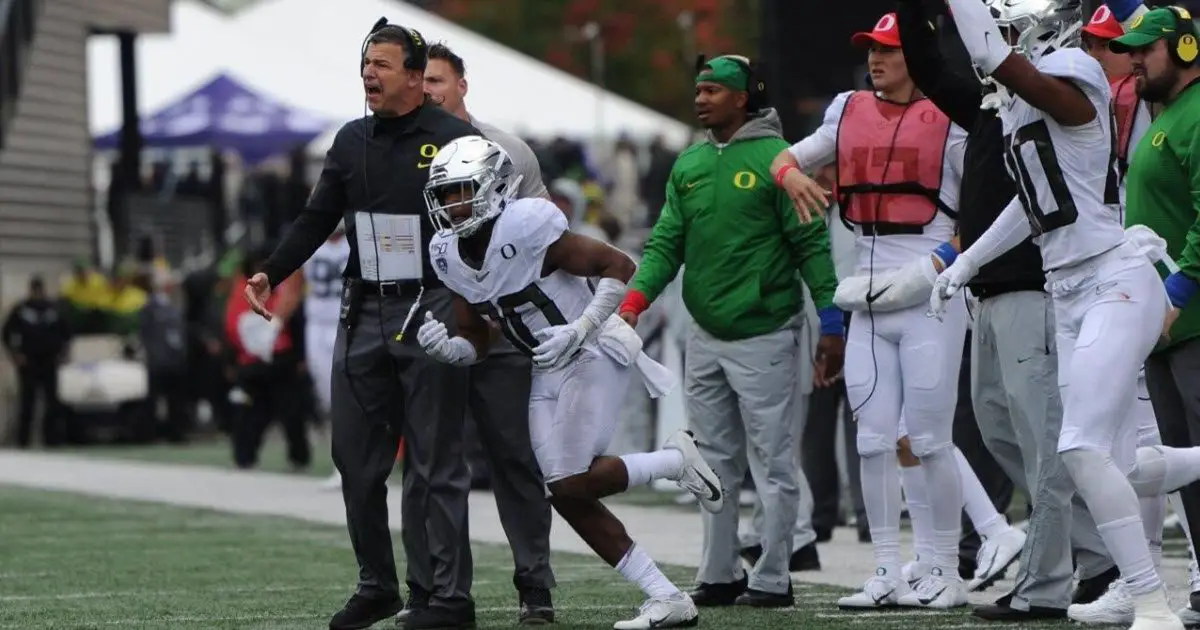Oregon fixed its biggest flaw against Washington on Saturday — a flaw that goes back to 2015 as the Mark Helfrich era was beginning to crumble. A flaw that lost somewhere in the vicinity of 10 games over the last four seasons.
Oregon made major coaching adjustments at halftime.
There was no collapse or letting the game slip away, as happened last year. The comeback wasn’t accomplished by simply making plays that the Ducks failed to make in the first 30 minutes (although that did help).
No; Mario Cristobal and his staff made the sort of adjustments at halftime that win football games.
The Running Game
Oregon did not run the ball well in the first half. CJ Verdell was hammered by an aggressive defensive Husky front, and aside from the first drive of the game, the holes he was running through were small or non-existent. The hits added up, and Verdell did not play in the second half.
Last season and early this season, Cristobal would have selected Travis Dye as the next man up. But Saturday, the second-year head coach made an adjustment that won him the game; he played Cyrus Habibi-Likio. The change in the No. 2 running back could have to do with Dye having ball security issues earlier in the season, or he could have made the change due the ability of Habibi-Likio to make a hole where there is none.

CJ Verdell took a beating against Washington
The change paid off in a huge way; Habibi-Likio finished the game with 81 yards on 14 carries. Verdell had 11 carries for only 48 yards in the first half. The 1.8 yard per carry difference between the two players was due to the ability of Habibi-Likio to break tackles. Where Verdell threw himself at defenders as hard as he could, Habibi-Likio made defenders miss or simply ran through contact.
The results of the more punishing running style were the Washington defensive front being worn down late in the game, giving up more and more chunk runs, and setting up the play-action pass.
The Passing Game
The gameplan in the first half saw QB Justin Herbert trying to throw the ball downfield against the young Husky secondary. While he had two TD passes, the Ducks struggled to move the ball due to solid coverage, and Herbert struggling to hit open targets.

Justin Herbert missed a few open looks against Washington
Cristobal decided to get Herbert going by re-implementing the screen game that Oregon has used so effectively this season. This allowed Herbert to start taking over, and it made it difficult for the Washington defense to cover because they always keep at least one safety about 20 yards deep, meaning lead blockers had time to get in front of the receiver targeted on the screen. This worked to perfection on Jaylon Redd’s two touchdowns, as well as on Mycah Pittman’s first score of the season.
The play action passing game was also used to better effect in the second half after Habibi-Likio began to gash the Washington defense. This led to linebackers freezing for a split second, which was all Herbert needed to hit the open receivers.
Defensive Adjustments
Husky Quarterback Jacob Eason looked really good in the first half against Oregon. For the first time all season, the Ducks’ secondary was missing assignments, leaving receivers wide open and allowing easy catches.
Part of the breakdown was due to Deommodore Lenoir leaving the game with an injury and not returning. But Thomas Graham allowed a long touchdown pass to be caught, and Jevon Holland allowed a huge catch right over his head. Oregon also missed tackles and allowed big runs in the first half. Couple that with sub-par secondary play and the Ducks looked like they were in big trouble.
Until they didn’t.

Oregon only had one sack against UW, and it was a big one.
On the second Washington possession of the second half, after giving up 45 yards on the first four plays of the drive, the Oregon defense figured it out. They gave up another first down on the drive — a false start — but the Washington offense stopped moving the ball. After kicking a field goal and getting the Husky lead to 10 points, the Ducks’ defense gave up only 47 yards over the remaining 18:39 in the football game. Twenty of those 45 yards came on a 3rd and 23 on the final Washington possession of the game.
The adjustment by the coaching staff was simple and effective: control the line of scrimmage at all costs. Washington ran the ball for 125 yards over the course of the game. Over their last three drives, they had a combined 10 rushing yards.
This control of the line of scrimmage, and Washington possessing the lead and insisting on running the ball, forced two straight three-and-outs. This proved devastating as Oregon scored two touchdowns over this period of time and regained the lead for good. The secondary did give up two big plays late, but they kept the offense in front of them and did not allow Eason to throw the ball over the top like he did in the first half.
Significance of the Victory

Mario Cristobal said he didn’t know Cyrus Habibi-Likio could jump this high.
Charles Fischer likes to say that both greatness and weakness reveal themselves early. Cristobal and his staff have shown greatness in recruiting great players, and weakness in managing games. They have failed to make necessary, and often obvious, adjustments in favor of staying the course. This has led many to criticize the coaching staff, and by Fischer’s logic they aren’t likely to change.
But on Saturday the Ducks proved that, maybe, greatness can figure it out at halftime — and beat the Huskies.
Ryan Robertson
Yuma, ArizonaTop Photo Credit: Tom Corno
 Natalie Liebhaber, the FishDuck.com Volunteer Editor for this article, works in the financial technology industry in Bozeman, Montana.
Natalie Liebhaber, the FishDuck.com Volunteer Editor for this article, works in the financial technology industry in Bozeman, Montana.
Related Articles:
Will The Coaching Carousel Kill Oregon's CFP Chances?
The Playoff Formula Hasn't Changed
Oregon Aims to Bury Dawgs, Punch Playoff Ticket in Rivalry Clash
Huskies Are the New Beavers, Stay In Your Lane Kiffin, and the Civil Apple Cup War
Oregon Football: The X-Factor Vs. Washington
Oregon vs. USC was the Game this Season Needed
Ryan Robertson is a defense contractor for the United States Marine Corps. A lifelong Duck fan from Grants Pass, he joined the Army out of high school. After four years as an Intelligence Analyst he decided it was time to further his education and pay more attention to his Ducks. One of Ryan’s first memories is of watching the Ducks, led by Joey Harrington, beating up on the Utah Utes in 2001. His grandfather ran track at Oregon in the ‘50s. He loves the Ducks, and has a passionate interest in reading every scrap of analysis centered around the football team.

